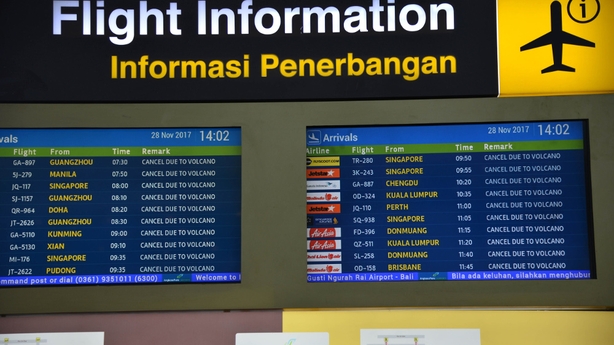Indonesia has extended the closure of the airport on Bali as ash from a volcano swept the island, stranding thousands of tourists as authorities tried to persuade villagers to leave their homes near the erupting mountain.
"Aircraft flight channels are covered with volcanic ash," the transport ministry said in a statement, citing aviation navigation authorities.
Bali's airport, about 60km from the Mount Agung volcano, will be closed until tomorrow morning local time, it said.
Frustration at the country's second-busiest airport is starting to boil over, with an estimated 2,000 people attempting to get refunds and reschedule tickets.
Ten alternative airports have been prepared for airlines to divert inbound flights, including in neighbouring provinces, the airport operator said, adding it was helping people make alternative bookings and providing food and entertainment for stranded travellers.
The airport on Lombok island, to the east of Bali, had been reopened, authorities said, as wind blew ash westward, toward the southern coast of Java island.


Agung towers over eastern Bali to a height of just over 3,000 metres.
Its last eruption in 1963 killed more than 1,000 people and destroyed several villages when it spewed out pyroclastic material, hot ash, lava and lahar (mudflow).
Life went on largely as normal in villages surrounding Agung, with residents offering prayers as the volcano sent columns of ash and smoke into the sky.
Some villagers who fled in September, when the alert was last raised to the highest level, have gone home despite government warnings.
Indonesia's Volcanology and Geological Disaster Mitigation Centre has warned that an eruption of a size similar to that seen in 1963 could send rocks bigger than a fist flying a distance of up to 8km, and volcanic gas a distance of 10km within three minutes.
Monitoring has shown the northeastern part of Agung's peak had swollen in recent weeks "indicating there is fairly strong pressure toward the surface", the centre said.
Despite a similar pattern of volcanic activity to that in 1963, which reached a peak after up to three months of ash emissions, it was not clear how long the current eruption would last, said David Pyle, a professor in earth sciences at OxfordUniversity.
"It remains possible that the eruptive crisis could continue for some time."

